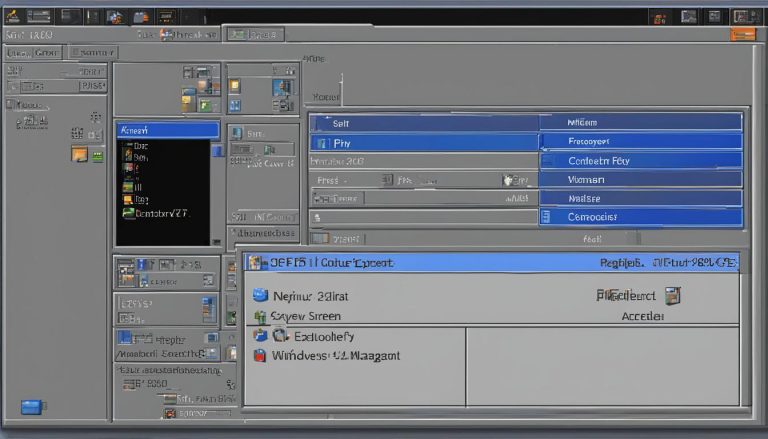Windows Services are a crucial component of the Microsoft Windows operating system. They enable the creation and management of long-running processes that can start without user intervention and continue running even after the user has logged off. These services perform various functions such as managing network connections, sound, data backup, user credentials, and display colors.
Similar to UNIX daemons, Windows Services can be managed through the Services Control Manager panel. Examples of Windows Services include Active Directory Service, Prefetch and Superfetch Service, Background Intelligent Transfer Service, DNS Client Service, and more.
If you are new to Windows Services or want to understand them better, this comprehensive guide is here to help. Whether you are a beginner or looking for a refresher, we will cover the basics, explain the concept, provide an overview, and guide you through the process of creating and configuring Windows Services. Let’s dive in!
Key Takeaways:
- Windows Services are a core component of the Microsoft Windows operating system.
- They allow the creation and management of long-running processes.
- Windows Services can start without user intervention and continue running after the user has logged off.
- They perform various functions such as managing network connections, sound, data backup, and user credentials.
- Windows Services are similar to UNIX daemons and can be managed through the Services Control Manager panel.
Definition and Functioning of Windows Services
Windows Services are a crucial component of the Microsoft Windows operating system that allow the creation and management of long-running processes. These services perform various functions and are designed to start without user intervention, continuing to run even after the user has logged off.
Similar to UNIX daemons, Windows Services manage important aspects of the operating system, such as network connections, sound, data backup, user credentials, and display colors. These services can be categorized into Local Services, Network Services, and System Services, each serving a specific purpose in maintaining the functionality of the Windows environment.
To effectively manage Windows Services, users can access the Services Control Manager panel. Here, they can view and configure the services, starting, stopping, pausing, resuming, and modifying their properties as necessary. Additionally, third-party applications can install their own services, extending the capabilities and functionality of the Windows operating system.
Table: Categories of Windows Services
| Category | Description |
|---|---|
| Local Services | Services that run in the security context of a local user account. |
| Network Services | Services that run in the security context of a domain account. |
| System Services | Services that are critical to the functioning of the operating system and run in the security context of the Local System account. |
Developers can create their own Windows Services using tools like Microsoft Visual Studio. Once created, these services can be installed using the InstallUtil.exe command-line utility. This allows developers to extend the functionality of the Windows operating system and tailor it to their specific needs.
By understanding the definition and functioning of Windows Services, users can harness the power of these services to optimize their system’s performance, customize the user experience, and ensure the smooth operation of their Windows environment.
Creating and Configuring Windows Services
To create Windows Services, developers can utilize tools such as Microsoft Visual Studio. After building the application, it can be installed as a service using the InstallUtil.exe command-line utility. Configuring Windows Services can be done through the Services Control Manager panel, which allows users to start, stop, pause, resume, and modify the properties of the services. Alternatively, the Services node in Server Explorer or the ServiceController class can be used for configuration.
When creating a Windows Service, developers have the ability to specify the commands that can be sent to the service and define the actions to be taken upon receiving those commands. This allows for customization and flexibility in the service’s behavior. Microsoft offers sample Windows Services projects on GitHub, showcasing different uses such as timer-based events, queue processing, and job scheduling.
Managing Windows Services involves ensuring their smooth operation and making any necessary adjustments. This includes monitoring the service’s performance, handling any errors or exceptions that may occur, and implementing any necessary updates or modifications. By effectively creating, configuring, and managing Windows Services, developers can optimize the performance and functionality of their applications.
Deploying and Servicing Windows Services
Deploying and servicing Windows Services is a crucial aspect of managing and maintaining a stable and efficient system. With the advancements in Windows 10 and Windows 11, deploying Windows Services has become simpler compared to previous versions. The in-place upgrade process allows for seamless migration from earlier versions while preserving important applications, settings, and data. This ensures a smooth transition and minimizes disruptions for users.
The deployment of Windows Services is done through servicing channels, which deliver feature updates and quality updates to client computers. The General Availability Channel provides new functionality with feature update releases, allowing organizations to choose when to deploy these updates. On the other hand, the Long-Term Servicing Channel is designed for specialized devices that require stability and security. It receives new feature releases every two to three years, providing a more controlled environment for critical systems.
When it comes to servicing Windows Services, organizations have the flexibility to defer feature updates and quality updates using various servicing tools. Windows Server Update Services (WSUS), Microsoft Configuration Manager, and Windows Update for Business are examples of tools that enable organizations to manage updates effectively. Quality updates are cumulative, containing both security and non-security fixes, ensuring the system’s stability and security are always up to date.
| Servicing Channel | Function |
|---|---|
| General Availability Channel | Delivers new functionality with feature update releases |
| Long-Term Servicing Channel | Designed for specialized devices, receives new feature releases every two to three years |
In summary, deploying and servicing Windows Services play a vital role in ensuring the stability, security, and performance of the system. With the advancements in Windows 10 and Windows 11, organizations have more streamlined methods for deploying updates while preserving important applications and data. By leveraging the various servicing tools available, IT professionals can effectively manage and maintain Windows Services, keeping the system up to date and secure.
Conclusion
Windows Services are a fundamental component of the Microsoft Windows operating system, enabling the creation and management of long-running processes. These services play a crucial role in managing network connections, sound, data backup, and user credentials, among other functions.
Developers can easily create and configure Windows Services using tools like Microsoft Visual Studio, and installation is a breeze with the InstallUtil.exe command-line utility. The ability to deploy and service Windows Services has been greatly improved in Windows 10 and Windows 11, making it simpler to update and maintain these services.
By understanding and leveraging the power of Windows Services, developers and IT professionals can enhance the performance, security, and functionality of their systems. Windows Services provide a flexible and reliable foundation for managing critical processes and ensuring smooth operation of the operating system.
FAQ
What are Windows Services?
Windows Services are a core component of the Microsoft Windows operating system that enable the creation and management of long-running processes. They perform various functions such as managing network connections, sound, data backup, user credentials, and display colors.
How do Windows Services differ from regular software?
Unlike regular software, Windows Services can start without user intervention and continue running even after the user has logged off.
How can Windows Services be managed?
Windows Services can be managed through the Services Control Manager panel, where users can view and configure the services. They can also be managed using the Services node in Server Explorer or with the ServiceController class.
How can developers create Windows Services?
Developers can create Windows Services using tools like Microsoft Visual Studio. After creating and building an application, they can install it as a service using the InstallUtil.exe command-line utility.
How can Windows Services be deployed and serviced?
Deploying Windows Services is simpler in Windows 10 and Windows 11 compared to previous versions of Windows. Feature updates and quality updates are delivered through servicing channels, and organizations can defer updates using tools like Windows Server Update Services (WSUS), Microsoft Configuration Manager, or Windows Update for Business.
Janina is a senior specialist in information technology


